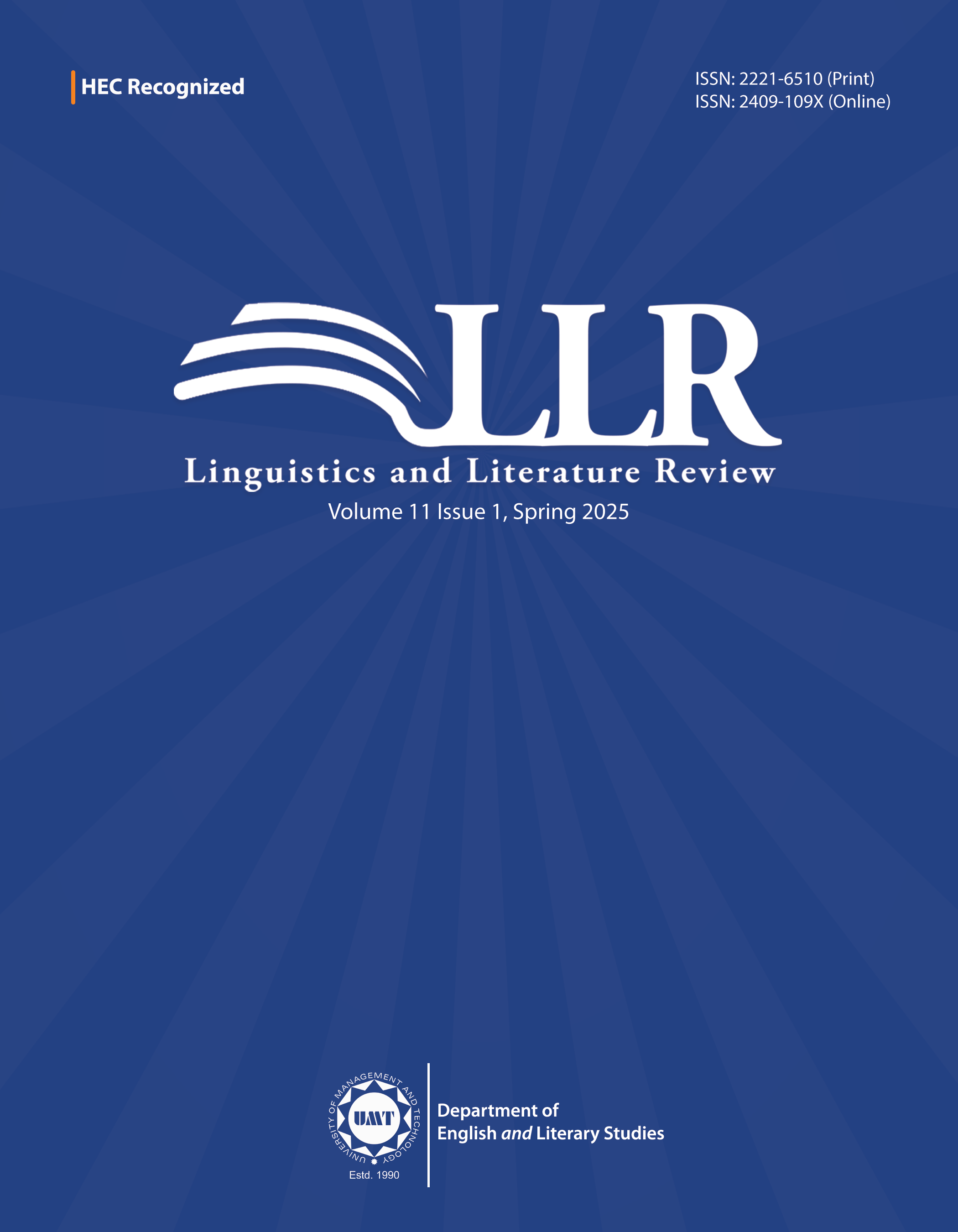Linguistic Impact: Exploring the Influence of Korean Dramas on Everyday Language of Pakistani Women
Abstract
 Abstract Views: 0
Abstract Views: 0
This study explores the linguistic and sociocultural impact of the Korean entertainment industry on Pakistani female audiences. This paper incorporates both, qualitative and quantitative methods of research. Grounded in Cultivation Theory, the research explores how prolonged exposure to Korean media shapes linguistic preferences and cultural inclinations. The long-term impact, due to the consumption patterns, unveiled the fact that there is an extensive impression of the Korean language on the language choices of Pakistani women. The reason behind the employment of such choices involves not only genuine appreciation but also staying updated with the trends of the world. The Korean language encompasses attractive intonation that captivates the attention of the listeners. In the research, sociocultural influence was highlighted because of the usage of Korean expressions in the daily use of the language of the participants. The present study investigated the wide range of Korean drama consumption, highlighted its linguistic impact, and the inspiration behind the language choices of the participants. Data was collected through a questionnaire to explore how exposure to Korean dramas affects language preferences and acquisition. For further research, this study also proposed some gateways between Urdu and Korean languages and the potential to incorporate diverse expressions in one’s language. The findings have provided the evidences of using Korean vocabulary and phrases in every day communication by Pakistani women in their informal conversation. Further, the study can be conducted to analyze the structural similarities between Pakistani and Korean languages which provide ease in adopting the Korean discourse.
Downloads
References
Anwar, R. P., & Anwar, W. W. (2014). The effect of Korean wave on young generation and creative industry in Indonesia. Masyarakat Modern dan Multikulturalisme, 4(2), 65–89.
Chan, B., & Seo, Y. (2011). Intercultural contact and language learning: The case of Korean language learning in Singapore. Seoul National University Press.
Cruz, A. G. B., Seo, Y., & Binay, I. (2021). Cultural globalization from the periphery: Translation practices of English-speaking K-pop fans. Journal of Consumer Culture, 21(3), 638–659. https://doi.org/10.1177/1469540519846215
Estavillo, M. (2012). Korean entertainment and cultural globalization. Seoul Cultural Studies Press.
Fatima, S., & Kewalramani, S. (2024). Effect of Korean drama on emotional expressivity. International Journal for Multidisciplinary Research, 6(2), 1–10.
Gerbner, G., & Gross, L. (1976). Living with television: The violence profile. Journal of Communication, 26(2), 172–199. https://doi.org/10.1111/j.1460-2466.1976.tb01397.x
Gerbner, G., Gross, L., Morgan, M., & Signorielli, N. (1980). The “mainstreaming” of America: Violence profile no. 11. Journal of Communication, 30(3), 10–29. https://doi.org/10.1111/j.1460-2466.1980.tb01987.x
Hayanda, F. F. (2022). The influence of Korean wave in improving English language skill. Research Gate. https://www.researchgate.net/publication/361727127_The_influence_of_Korean_wave_in_improving_English_language_skill
Kim, S., & Tahira, I. (2022). The Korean wave in the minds of Pakistani students in Korea. Journal of Asian Sociology, 51(2), 157–190.
Miranda, A. C., & Estoque, M. L. (2023). Effect of Korean drama on vocabulary and grammar in speaking English of junior high school students. International Journal of Advanced Research in Science, Communication and Technology, 3(2), 1098–1115. https://doi.org/10.48175/IJARSCT-11927
Morgan, M., Shanahan, J., & Signorielli, N. (2017). Cultivation theory in the 21st century. Routledge.
Noor, N. M. (2022). Rise of East Asian media connection: Japanese and Korean cultural globalisation through media. Al-i'lam: Journal of Contemporary Islamic Communication and Media, 2(1), 75–91. https://doi.org/10.33102/jcicom.vol2no1.39
Otmazgin, N. K., & Lyan, I. (2014). Hallyu across the desert: K-pop fandom in Israel and Palestine. Cross-Currents: East Asian History and Culture Review, 9, 32–55. https://doi.org/10.1353/ach.2014.0008
Saleem, H., Hatim, J., & Bibi, J. (2023). Youth perspectives on Korean dramas: Effects and responses. Global Multimedia Review, 6, 53–61. https://doi.org/10.31703/gmr.2023(VI-I).05
Sughra, S. F., Shahzad, M., & Abbas, I. (2022). The linguistic influence of Korean wave from Pakistan's perspective. Pakistan Journal of Social Research, 4(1), 533–550.
Touhami, B., & Al-Haq, F. A.-A. (2017). The influence of the Korean wave on the language of international fans: Case study of Algerian fans. Sino-US English Teaching, 14(10), 591–602. https://doi.org/10.17265/1539-8072/2017.10.004
Tse, T., & Tsang, L. T. (2018). Reconceptualising prosumption beyond the "cultural turn": Passive fashion prosumption in Korea and China. Journal of Consumer Culture, 18(2), 130–150. https://doi.org/10.1177/1469540517745700
Yoon, K. (2017). Cultural translation of K-pop among Asian Canadian fans. International Journal of Communication, 11, 2350–2366.
Copyright (c) 2025 Asma Naz

This work is licensed under a Creative Commons Attribution 4.0 International License.

This work is licensed under a Creative Commons Attribution 4.0 International License. Authors retain copyright and grant the journal right of first publication with the work simultaneously licensed under a Creative Commons Attribution (CC-BY) 4.0 License that allows others to share the work with an acknowledgment of the work’s authorship and initial publication in this journal.







